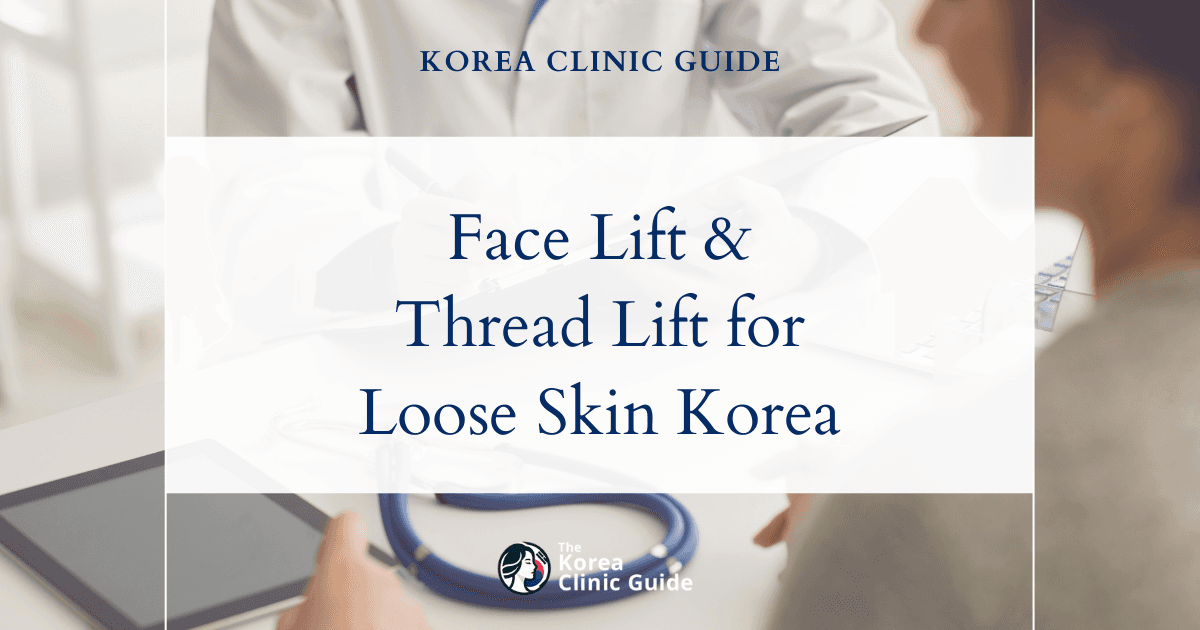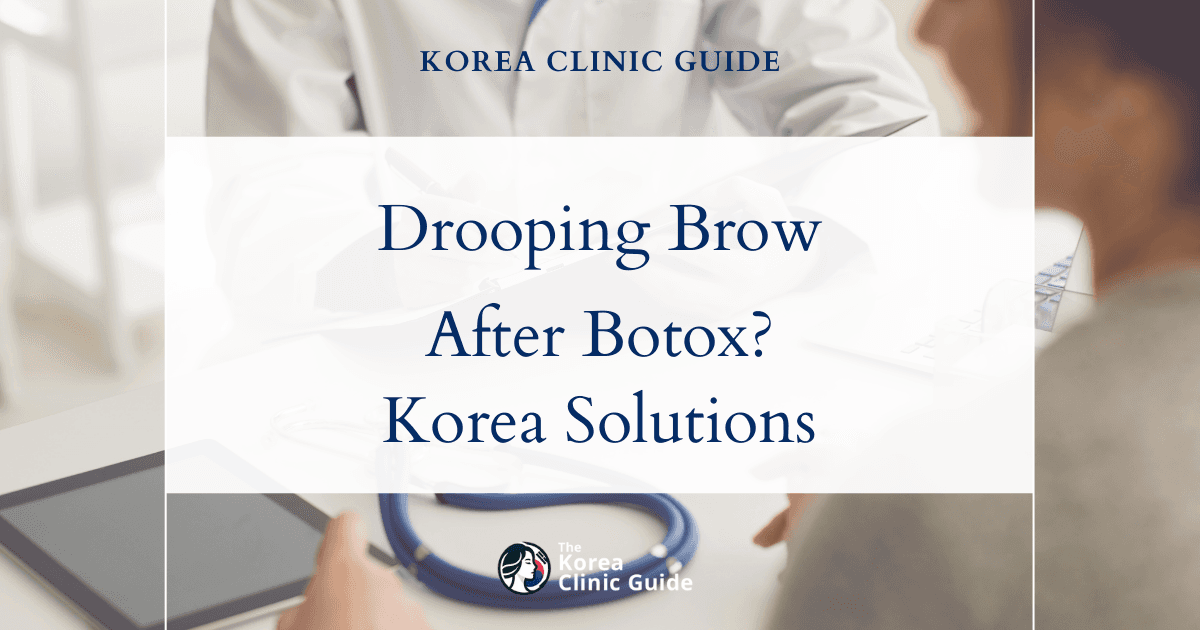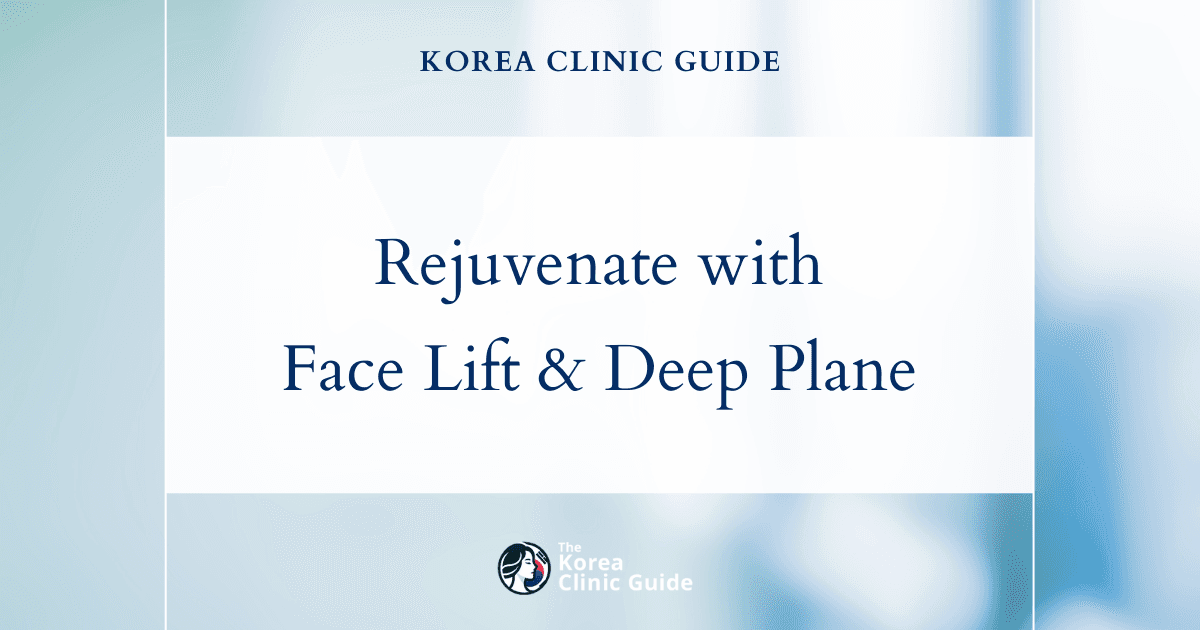Medical Tourism Blog
Deep Plane Face Lift in Korea | Best Clinics, Costs, Procedure Types & More

Table of contents
- What Is Deep Plane Face Lift?
- Best Clinics in Korea for Deep Plane Face Lift
- Deep Plane Face Lift in Korea
- Cost of Deep Plane Face Lift in Korea
- Alternatives to Deep Plane Face Lift
- Conclusion
What if you could turn back the clock on your face with a procedure that lifts not just the skin, but the deeper layers beneath for a truly natural, youthful look? The Deep Plane Face Lift, rapidly gaining popularity in Korea, offers just that—advanced surgical rejuvenation that restores facial contours without the artificial tightness of traditional facelifts. Known for its expert surgeons and cutting-edge technology, Korea has become a premier destination for this transformative procedure, balancing exceptional results with competitive costs. This article unpacks everything you need to know about the Deep Plane Face Lift in Korea, from the surgical approach and recovery to pricing and alternative options.
The deep plane face lift has gained significant popularity in Korea as an advanced surgical technique for achieving a natural and youthful facial rejuvenation. In this article, we will explore what a deep plane face lift entails, highlighting its unique approach compared to traditional facelift methods. We will also delve into why Korea has become a sought-after destination for this procedure, examining factors such as expertise, technology, and patient care. Additionally, the article will provide an overview of the cost of deep plane face lifts in Korea, helping prospective patients understand the financial considerations involved. Finally, we will discuss alternative treatments and procedures that offer different options for facial rejuvenation, allowing readers to make informed decisions about their aesthetic goals.

What Is Deep Plane Face Lift?
The Deep Plane Face Lift is an advanced surgical procedure designed to rejuvenate the face by addressing the deeper layers of facial tissue, including muscles and connective tissue, rather than just tightening the skin. This technique provides a more natural and long-lasting youthful appearance compared to traditional facelift methods, which primarily focus on the superficial layers.
Who Is It For?
The Deep Plane Face Lift is ideal for individuals experiencing moderate to severe signs of facial aging, such as:
- Sagging cheeks and midface
- Deep nasolabial folds (the lines running from the nose to the corners of the mouth)
- Jowls and loose skin along the jawline
- Loss of facial volume and definition
Typically, candidates are men and women in their 40s to 60s who want a significant facial rejuvenation without the overly “pulled” look sometimes associated with conventional facelifts. It is especially beneficial for those who have noticed that less invasive treatments like fillers or superficial facelifts have not provided sufficient or lasting results.
Procedure Types and Techniques
The Deep Plane Face Lift involves repositioning the deeper layers of the face, including the superficial musculoaponeurotic system (SMAS) and the underlying facial muscles, to restore youthful contours. Unlike traditional facelifts that pull the skin taut, this method lifts the entire facial soft tissue as a single unit, which helps maintain natural facial expressions and reduces tension on the skin.
There are several variations of the Deep Plane Face Lift, often tailored to the patient’s specific anatomy and aging pattern:
- Standard Deep Plane Lift: Focuses on lifting the midface and lower face by releasing and repositioning the SMAS and deep facial tissues.
- Extended Deep Plane Lift: Includes additional dissection around the neck and jawline to address more pronounced jowling and neck laxity.
- Combination Procedures: Sometimes combined with other facial rejuvenation techniques such as fat grafting, eyelid surgery (blepharoplasty), or brow lifts to achieve comprehensive facial harmony.
Surgical Approach
The surgery is typically performed under general anesthesia and involves incisions placed strategically around the hairline and ears to minimize visible scarring. The surgeon carefully separates the skin from the underlying deep plane layer, lifts and repositions the tissues, and then re-drapes the skin without excessive tension. This approach not only restores volume and contour but also improves skin texture and elasticity over time.
Recovery from a Deep Plane Face Lift usually takes about two to three weeks, with most patients returning to normal activities within a month. Swelling and bruising are common initially but gradually subside, revealing a refreshed and natural-looking facial appearance.
In Korea, where cosmetic surgery is highly advanced and popular, the Deep Plane Face Lift is performed by experienced plastic surgeons who utilize cutting-edge techniques and technology to ensure optimal results tailored to each patient’s unique facial structure.
Best Clinics in Korea for Deep Plane Face Lift
Listed below are the best clinics in Korea for deep plane face lift:
| Clinic Name | Key Features | Special Techniques |
|---|---|---|
| THEPLUS Plastic Surgery | Located in Garosu-gil, Gangnam, Seoul; team of highly accomplished surgeons; comprehensive care across four floors; commitment to patient safety and continuous advancement; active contributors to academic research and education | Rhinoplasty, facial contouring, breast surgery, Deep Plane Face Lift |
| Made Young Plastic Surgery | Located in Gangnam, Seoul; commitment to patient safety; blend of traditional beauty ideals with latest surgical techniques; personalized care; comprehensive suite of procedures | Deep Plane Face Lift, facial contouring, non-invasive lifting treatments, rhinoplasty, specialized eye surgeries |
THEPLUS Plastic Surgery
THE PLUS Plastic Surgery clinic, located in the vibrant Garosu-gil area of Gangnam, Seoul, stands at the forefront of advanced cosmetic surgery in Korea. The clinic is renowned for its team of highly accomplished surgeons, including Dr. Kim, Dr. Jeong, and Dr. Lee, each of whom brings a wealth of expertise and international recognition to their respective specialties. Dr. Kim, a board-certified plastic surgeon and award-winning researcher in 3D implants, is a leading authority in rhinoplasty and facial contouring, and is dedicated to achieving natural, harmonious results for every patient. Dr. Jeong, President of the Korean Society of Plastic Surgeons, is celebrated for his innovative approach to combining function and beauty, particularly in rhinoplasty, and is a sought-after speaker at global industry forums. Dr. Lee, with her extensive background in breast augmentation and experience at top hospitals, ensures natural and lasting outcomes for her clients.
Spanning four floors designed for comprehensive care, THE PLUS Plastic Surgery offers a full spectrum of services, from initial consultation to surgery and post-operative skincare. The clinic’s surgeons are not only skilled practitioners but also active contributors to academic research and education, regularly presenting at international conferences and publishing in leading medical journals. Their commitment to patient safety, satisfaction, and continuous advancement in surgical techniques has earned THE PLUS a stellar reputation both in Korea and abroad. Whether seeking facial contouring, rhinoplasty, breast surgery, or advanced facelift procedures such as the Deep Plane Face Lift, patients at THE PLUS can expect personalized care and exceptional results delivered by some of the most respected professionals in the field.
You can check out their website here: THEPLUS Plastic Surgery Website
Made Young Plastic Surgery
Made Young Plastic Surgery Clinic, located in the heart of Seoul’s renowned Gangnam district, stands as a leader in the field of aesthetic and rejuvenative surgery. The clinic is celebrated for its unwavering commitment to patient safety and its innovative blend of traditional beauty ideals with the latest surgical techniques. With a philosophy rooted in delivering natural, harmonious results, Made Young has become a trusted destination for those seeking to restore youthful vitality and confidence.
The clinic’s team comprises highly skilled plastic surgeons, anesthesiologists, and dedicated medical staff, all focused on providing personalized care tailored to each patient’s unique needs. Made Young offers a comprehensive suite of procedures, including advanced face lift surgeries such as the Deep Plane Face Lift, facial contouring, non-invasive lifting treatments, rhinoplasty, and specialized eye surgeries. Every treatment is designed not only to enhance appearance but also to foster a renewed sense of self-assurance and well-being, making Made Young a beacon of excellence in Korean plastic surgery.
You can check out their website here: Made Young Plastic Surgery Website
Deep Plane Face Lift in Korea
Undergoing a Deep Plane Face Lift in Korea is a comprehensive and highly specialized procedure designed to rejuvenate the face by addressing sagging skin, deep wrinkles, and loss of facial volume. Korea is renowned for its advanced medical technology and skilled plastic surgeons, making it a popular destination for this type of facial rejuvenation.
Initial Consultation and Assessment
The process begins with an in-depth consultation at a reputable clinic or hospital. During this session, the surgeon evaluates your facial structure, skin condition, and discusses your aesthetic goals. They may use 3D imaging technology to show potential results and tailor the procedure to your unique anatomy. This step is crucial for setting realistic expectations and planning the surgery.
Preoperative Preparation
Once you decide to proceed, you will receive detailed preoperative instructions. These typically include guidelines on medications, smoking cessation, and fasting before surgery. Korean clinics often provide comprehensive care packages, including accommodation and transportation, especially for international patients.
The Surgical Procedure
The Deep Plane Face Lift is performed under general anesthesia in a sterile operating room. Unlike traditional facelifts that only tighten the skin, this technique involves lifting the deeper layers of facial muscles and tissues (the "deep plane") to achieve a more natural and longer-lasting result.
The surgeon makes incisions typically around the hairline and ears, carefully lifting the skin to access the underlying muscles and connective tissues. By repositioning these deeper layers, the procedure restores youthful contours and smooths out sagging areas without creating a stretched or artificial appearance. Excess skin is trimmed, and the incisions are meticulously closed to minimize scarring.
Duration and Recovery
The surgery usually takes between 3 to 5 hours, depending on the extent of the lift and any additional procedures performed simultaneously, such as eyelid surgery or fat grafting. After the operation, patients are monitored in a recovery room before being discharged, often the same day or after an overnight stay.
Recovery in Korea is supported by advanced postoperative care. Patients typically experience swelling, bruising, and mild discomfort for the first week. Korean clinics provide detailed aftercare instructions, including wound care, medication schedules, and follow-up visits. Many patients stay in Korea for about one to two weeks post-surgery to ensure proper healing and to attend follow-up appointments.
Postoperative Care and Follow-Up
Follow-up visits are an integral part of the process, allowing the surgeon to monitor healing and address any concerns. Korean medical facilities emphasize patient education and support, often offering multilingual staff to assist international patients.
Patients are advised to avoid strenuous activities for several weeks and to protect their skin from sun exposure. The final results of a Deep Plane Face Lift in Korea typically become fully apparent after several months, revealing a rejuvenated, natural-looking face with improved contours and reduced signs of aging.
Cost of Deep Plane Face Lift in Korea
The cost of a Deep Plane Face Lift in Korea varies depending on the clinic, surgeon’s expertise, and the specific techniques used. Generally, the price range for this advanced facelift procedure in Korea is between ₩8,000,000 to ₩15,000,000 (approximately $6,000 to $11,000 USD). High-end clinics in Seoul or other major cities may charge towards the upper end of this range due to their reputation and advanced facilities, while smaller clinics or those outside metropolitan areas may offer more affordable rates.
Additional Travel Expenses
When considering a Deep Plane Face Lift in Korea, it’s important to factor in travel-related costs:
-
Flight Costs: Round-trip airfare to Korea varies widely depending on your departure location and the time of year. For example, flights from the United States or Europe typically range from $700 to $1,500 USD. Flights from neighboring Asian countries can be significantly cheaper, often between $100 to $500 USD.
-
Accommodation: Depending on your preferences, accommodation costs can range from budget guesthouses at around ₩30,000 to ₩70,000 per night ($25 to $60 USD) to luxury hotels costing upwards of ₩150,000 per night ($120 USD or more).
-
Local Transportation: Public transportation in Korea is efficient and affordable, with subway and bus fares usually under ₩2,000 ($1.50 USD) per trip. Taxi fares start at about ₩3,000 ($2.50 USD).
-
Food and Miscellaneous: Daily expenses for meals and other necessities can vary, but a reasonable budget would be around ₩30,000 to ₩50,000 ($25 to $40 USD) per day.
Summary of Estimated Costs
| Expense Category | Low Range (USD) | High Range (USD) |
|---|---|---|
| Deep Plane Face Lift | $6,000 | $11,000 |
| Round-trip Flight | $100 | $1,500 |
| Accommodation (1 week) | $175 | $840 |
| Local Transportation | $10 | $30 |
| Food and Miscellaneous | $175 | $280 |
Overall, patients should budget approximately $6,460 to $13,650 USD for the entire trip, including the surgery and travel expenses, depending on their choices and location.
Alternatives to Deep Plane Face Lift
When considering facial rejuvenation, several alternatives to the Deep Plane Face Lift offer effective results with varying techniques and recovery times. Here are three popular options:
1. SMAS Face Lift
The SMAS (Superficial Musculo-Aponeurotic System) Face Lift targets the deeper layers of facial tissue, similar to the Deep Plane technique, but focuses primarily on the SMAS layer. This procedure lifts and tightens the underlying muscles and connective tissue, providing a natural and long-lasting rejuvenation effect. It is less invasive than the Deep Plane Face Lift and typically involves a shorter recovery period.
2. Thread Lift
A Thread Lift is a minimally invasive procedure that uses temporary sutures to lift and tighten the skin. Threads are inserted under the skin to pull it upward, stimulating collagen production for improved skin texture and firmness. This option is ideal for patients seeking subtle lifting with minimal downtime. However, the results are generally less dramatic and shorter-lasting compared to surgical face lifts.
3. Liquid Facelift
The Liquid Facelift involves the use of injectable fillers and neuromodulators (such as Botox) to restore volume, smooth wrinkles, and enhance facial contours without surgery. This non-invasive approach offers immediate results with little to no recovery time. While it does not provide the same lifting effect as a surgical face lift, it is a popular choice for those looking to refresh their appearance with minimal risk.
Conclusion
In conclusion, the Deep Plane Face Lift is a highly advanced surgical technique that offers natural and long-lasting rejuvenation by addressing deeper facial structures, making it a popular choice for those seeking significant anti-aging results. Korea has emerged as a leading destination for this procedure, combining expert surgeons with state-of-the-art facilities, often at a more affordable cost compared to Western countries. While the investment in a Deep Plane Face Lift can be substantial, many find the results justify the expense, though it is important to consider alternative treatments such as thread lifts or non-surgical options for those with different needs or budgets. Ultimately, thorough research and consultation with qualified professionals in Korea can help patients make informed decisions tailored to their aesthetic goals and financial considerations.









